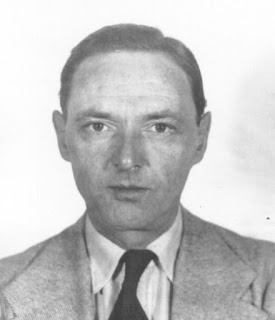The Book
Cargo of Lies: The True Story of a Nazi Double Agent in Canada. Dean Beeby. Toronto University Press, Toronto, 1995.
Summary
You know that saying, “Don’t judge a book by its cover”? Well… that saying applies to this book! Looking at the cover, you might expect some semi-fictionalized fantastical pseudo-historical story but… the cover is misleading. Cargo of Lies is exquisitely well-researched and was a real pleasure to read.
Beeby, a Canadian journalist, managed to obtain the original police files on the case through Freedom of Information requests. Published in 1995, before the MI5 files were declassified, the book does have a few gaps, which the author freely acknowledges. A quick search on the National Archives website, however, reveals no files for the case. Interesting

As for the book itself, it tells the tale of two German espionage agents who were separately deposited on the coast of Canada from submarines in 1942.
Most of the book deals with Werner Alfred Waldemar von Janowski who landed near New Carlisle, QC, on November 9, 1942. Janowski aroused suspicions in the small community and was arrested the next day. A bit of a turf battle ensued between various agencies (Quebec Provincial Police, RCMP, Naval Intelligence) but when the dust had settled, Janowski was nestled in the firm, if tentative, embrace of the RCMP.
Despite having no espionage or double-cross system experience, the RCMP decided to try and run Janowski as a double agent (WATCHDOG). Even though there were numerous leaks in the press about the capture of a German solider/sailor/spy along the coast of Quebec, the authorities believed it unlikely that this would affect their double-cross plans. The naive Canadian intelligence amateurs eventually received some assistance from Cyril Mills, the MI5 case officer for double-agent GARBO. But… by August 1943, the case was dead in the water as it became clear that Janowski was likely a triple-cross agent.
He was quietly shipped off to Camp 020 in England where Major Robin W.G. Stephens and his team had a go at the hapless agent. Janowski was variously described as a “fluent and fertile liar” and a “loyal dissembling Nazi”. He told the authorities several different versions of his history but, in the end, it was quite clear that he had been involved in the Nazi Party and that he was a well-trained and experienced sabotage expert. He remained at Camp 020 until the end of the war and was then shipped back to Germany.

One chapter in the book is devoted to the tale of Alfred Langbein (alias Alfred Haskins). He was landed from a submarine in the Bay of Fundy in May 1942. Langbein was cut from very different cloth than Janowski however. Langbein had become disillusioned with the political situation in Germany and saw his mission to Canada as a way to escape the Nazis and, at war’s end, bring his wife and children to a new country.
Upon landing, Langbein buried his uniform and radio transmitter. Despite his accent and out-of-date Canadian bills, he was able to make his way to Montreal and then Ottawa where he lived an unassuming life, attracting no attention.
On November 1, 1944, Langbein gave himself up to a Naval Intelligence officer and was passed along to the RCMP. Cyril Mills from MI5 was involved in the initial interrogation of Langbein. It quickly became clear that the poor German was being “straightforward and honesty throughout” as he recounted his story. Too stale to serve as a double-cross agent, Langbein was sent to an internment camp near Fredericton, NB and repatriated at the end of the war.
Review
What I found most interesting in both of these stories, was the stories that lay behind both men. They had both spend several years in Canada in the 1920/1930s and were familiar with the country. In that respect, they were both good choices for espionage missions to Canada. Janowski was also relatively experienced as he had participated in a sabotage mission in French Morocco and been involved in the invasion of the Lowlands in May 1940. Langbein, on the other hand, had apparently joined the Abwehr in an attempt to avoid being conscripted into the German Army. He was originally trained as an agent to be dispatched to England as part of Operation LENA in August 1940. On his way to Brussels, and with his third child about to be born, Langbein changed his mind and refused the mission. The Abwehr apparently handled his refusal quite well. Langbein recounted a conversation he had had with Karl Gartenfeld, the Heinkel 111 pilot involved in Operation LENA:
“On one occasion [Gartenfeld] told me that he considered his business of dropping parachute agents in England was the profession of a butcher.”
Beeby’s book provides quite a bit of information on how both Janowski and Langbein were prepared for their missions. Langbein’s story in particular is of interest because of his tangential connection with Operation LENA. His list of equipment, identification papers, training, etc. are all of interest in comparison with the LENA spies. Interestingly, Langbein was told by his Abwehr superiors to get a haircut as soon as he arrived in Canada to eliminate the distinctive German hairstyle. Fascinating.
I thoroughly enjoyed this book and found it very well researched and quite helpful. I found Beeby’s writing style to be engaging. It isn’t all “dry facts” and he weaves in the stories of various characters quite seamlessly. Given that news reports of the day, and even after the war, contained a lot of rumours and exaggerations, it is nice to see an account of the story that relies on original source documentation.
I do have to admit that Janowski has an unfortunate face and does rather fit the image of a “loyal dissembling Nazi”! I also find it interesting to read Stephens’ description of the Janowski case from the Camp 020 book (edited by Oliver Hoare). Stephens’ penchant for exaggeration and flamboyancy tends to shine through. According to Stephens, Janowski “attracted immediate attention by ordering a bath in his hotel, for in those northern regions no one bathed at that time of year”. (FYI – latitude of New Carlisle QC is 48°N and the latitude of London/Camp 020 is 51°N.) It would appear that Stephens’ well-documented xenophobia towards other nationalities may need to be expanded to encompass his disparaging comments about the hygiene habits of (filthy) colonial Canadians.
Review Score
5 out of 5 – well-researched and yet an easy, enjoyable and informative read.
